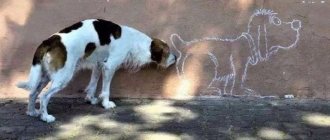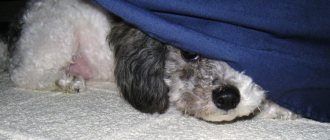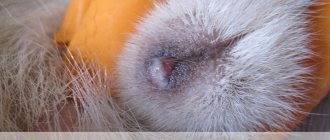The birth of newborn babies does not mean the complete completion of the physiological process of procreation. The body of a new mother requires a recovery period, during which discharge from the female genitals is observed. It is the owner's responsibility to promptly recognize when lochia is considered normal and when to seek veterinary help.
Normal postpartum discharge
Normally, from the birth canal of a whelping bitch, mucous, bloody or mixed with blood, discharge - lochia - may be released for another 3-6 weeks. Gradually their number should decrease and eventually stop altogether. However, the process of natural cleansing of the uterus must be monitored so as not to miss the alarming symptoms of pathology.
Normally, the discharge from the loop changes its consistency and color. The first few days after birth, lochia can normally look like this:
- grayish or light green discharge, dense consistency interspersed - this is the remains of amniotic fluid and fragments of the placenta coming out of the uterine cavity. The smell of the discharge should not cause disgust;
- lochia of a dark, almost black color without a putrid odor is also considered normal. The dark color of the mucus is given by coagulated blood from the capillaries, which flows out when the placenta is expelled;
- dark mucus with a brownish or greenish tint is ichor and traces of blood in the amniotic fluid and mucus.
If the lochia is not too abundant and has a normal consistency and smell, then there is no need to worry. Discharge from the loop may be accompanied for the first few days by low-grade body temperature and physiological diarrhea, which, as a rule, ends after 1-2 days.
Owners may be alarmed by the strange behavior of the dog - it begins to behave as if a few hours before contractions:
- leaves the nest;
- fusses;
- digs litter;
- breathing heavily and intermittently.
Some people confuse this behavior with symptoms of “milk fever” - eclampsia. But the reason is discomfort in the dog, which is caused by contractions of the uterus and irritation of sensitive nipples when feeding puppies.
As a rule, this condition goes away on its own, but to be on the safe side, you can consult a veterinarian. The dog is given a mild sedative and painkiller - No-shpu or Baralgin in a dosage depending on the size of the pet. Concerns should arise if lochia becomes more abundant or an unpleasant odor is felt.
The natural process of cleansing the uterus
The natural process of cleansing the body in females after the birth process and expelling not only all fetuses, but also the placentas of their uterus, is characterized by the appearance of lochia. These are postpartum discharges that appear as a result of the release of specific hormonal substances into the systemic circulation.
In turn, hormones provoke increased contraction of the muscle fibers of the uterus, accelerating the process of cleaning the uterine cavity from particles of the dead epithelial layer, placenta and formed clots.
Involution, or the return of the uterus to its original prenatal state, is accompanied by discharge from the loop. During childbirth and several days after the completion of the birth process, natural discharge from the vagina and vulva is characterized by a rich reddish-brown color, sometimes with a green tint.
The gray-green color of the discharge is considered normal in the first few days after birth and is caused by the escaping remains of amniotic fluid and parts of the placenta. Lochia should not have a disgusting odor. The presence of grain-like clots is acceptable and does not cause concern.
Physiologically, discharge in dogs after birth lasts 3-4 weeks. The first few days after the birth of puppies, the discharge from the female's loop may be transparent in the form of mucus interspersed with green color (green color in veterinary medicine is considered coagulated protein and does not cause concern).
Lochia can be black in color, which also refers to physiological discharge. They should not have any foreign odor, especially putrid odor. The duration of the first stage of cleansing is several days after the completion of the birth process.
If the owner notices bloody discharge, it is necessary to monitor the pet more closely. If a large amount of blood appears in the discharge, you should contact your veterinarian for help.
In order to control the color and amount of secretion released from the uterus during the process of involution, it is recommended to lay white fabric or disposable waterproof sheets in the dog’s nest. This will allow you to record all types of discharge and monitor the clinical picture.
Normally, a few days after birth, the color of the discharge changes from black-green and brown to brown. At the end of the third week, the discharge should become pale pink and mucous. At the end of the cleaning process, the lochia becomes transparent and stops.
The size of the female, the number of puppies brought and breed predisposition directly affect the amount and duration of discharge.
Discharge during postpartum pathology
The cause of abnormal discharge can be either an inflammatory process due to infection and injury to the reproductive organs, or the consequences of intrauterine death of puppies. The following discharges are considered pathological:
- Liquid, copious discharge mixed with blood may indicate that the baby's place has not completely receded. If the contraction of the cervix occurs too quickly, the remnants of the placenta remain in the uterine cavity, causing an inflammatory process. Subsequently, a secondary infection may occur, and pus will appear in the lochia. In this case, an urgent consultation with a veterinarian is required, who, using drugs that stimulate uterine contractions, will help clear it of contents.
- Dark discharge with a putrid odor may indicate the process of decomposition of fragments of the placenta or dead fetus. When intoxicated with decay products, the dog experiences a febrile temperature, signs of fever, muscle weakness and refusal to eat. Urgent medical care consists of surgical removal of the organ or cleaning it, followed by drug therapy.
- Copious bleeding of a dark or bright scarlet color indicates uterine bleeding or uterine rupture. If measures are not taken in time, heavy blood loss can lead to the death of the pet.
Any alarming signs, changes in the behavior or condition of the animal require consultation with a specialist. If the owner is not sure whether the discharge is normal, then it is worth inviting a veterinarian to the house to examine the dog. But even with the normal process of cleaning the uterus, measures should be taken to prevent the risk of postpartum infection.
Interesting:
- how to do an ultrasound on a dog;
- diets for dogs;
- vitamin deficiency in dogs.
[custom_ads_shortcode2]
Precautions during the postpartum period
During the periods between estrus and childbirth, the cervix is closed, which prevents infection from entering the uterine cavity. For several more weeks, the cervix is slightly open, which facilitates the free release of the remaining amniotic fluid and placenta. During this period, the entry of pathogenic microorganisms is not limited, and therefore precautions should be taken:
- immediately after birth, change the bedding in the “nest” with traces of blood and amniotic fluid;
- do not prevent the dog from licking the loop. Her saliva contains enzymes that promote blood coagulation and have a disinfecting effect;
- change the dog's bedding daily, avoiding contamination and wrinkles;
- wash the animal not only after birth, but also subsequently after each urination and defecation;
- to avoid congestion in the uterus, you should douche once a week with a warm solution of syntomycin emulsion;
- do not allow the animal to become hypothermic or overheated;
- food and water are placed close to the “nest” so that the dog does not become nervous when leaving the litter;
- take the dog out to relieve itself in a gentle manner - you should not allow it to actively move or take long walks.
Compliance with the listed rules of prevention during the postpartum period will reduce the risk of infection and postpartum complications.
The owner of the bitch should also be concerned about discharge that lasts more than a month after the end of the birth process. In addition to discharge from the loop during the development of pathology, there is a general depression of the animal’s condition, refusal to feed, hyperthermia, and disturbances in the breathing process (shortness of breath).
Most females, even if they feel unwell, continue to actively care for and feed the puppies. This in turn leads to dangerous complications.
The danger of the postpartum period is that not complete cleansing of the internal layers of the uterus, a dead fetus, remnants of the placenta or placenta may remain inside. The cervix closes and does not allow large particles of tissue structures to pass through. Remaining in the organ cavity, they undergo a process of decay.
Discharge from the loop in a female, characterized by a watery consistency and a large amount, indicates that the baby's place has not completely separated. It is necessary to urgently take the pet to a veterinary clinic, since the remnants of the placenta interfere with the proper contraction of the uterus, provoking the development of an inflammatory process. Early diagnosis will avoid surgical intervention. The pathological process can be eliminated with the help of drug therapy.
Black discharge in the first 24-48 hours after birth is considered natural, but only if it does not have a strong odor. Otherwise, such discharge indicates the presence of an afterbirth in the uterus or a dead fetus. Remaining in the uterine cavity, the tissues undergo rotting, causing general intoxication of the body. The dog becomes lethargic, vomiting and an increase in body temperature.
In the absence of qualified assistance, the female dies from sepsis. Elimination of the pathological process is eliminated surgically with the further administration of a course of restorative therapy.
Copious brown discharge streaked with blood or a bright scarlet color indicates the development of bleeding in the uterine cavity. The duration of bleeding negatively affects the general condition of the female’s body, weakened after childbirth. The animal quickly loses its vitality and dies as a result of heavy blood loss.
The bloody appearance of the discharge indicates the development of necrotic processes in the uterus associated with the placenta not fully expelled. The condition requires immediate medical attention. In the absence of timely assistance, the dog develops necrosis, blood poisoning, accumulation of large amounts of pus in the cavity and, as a result, rupture of the uterine walls. Necrosis can also develop when a dead puppy remains in the uterus.
A hidden threat to the health of the female after childbirth is the development of acute metritis. The pathological process develops in the walls of the uterus against the background of infection of the birth canal. This can happen with improper obstetric care or immediately after it.
Metritis is associated with a delay in the release of membranes, a child's place or a fetus in the uterine cavity for longer than 24 hours. The cause of metritis can be pathogenic bacterial microorganisms that penetrate through the systemic bloodstream into the reproductive system from the intestinal tract or urinary organs. In the case of metritis, the discharge from the loop has a characteristic pungent, repulsive odor and a dirty brownish color.
Physiologically, the cervix is closed and serves as a kind of protective barrier against the entry of various pathogenic microflora into the uterine cavity. Before giving birth in dogs and during the onset of heat, the cervix opens, which causes the penetration of various pathogens that provoke the development of pathological processes.
In order to avoid the development of complications during childbirth, it is necessary to carefully monitor the process. It is recommended to call a veterinarian or have the number of the nearest veterinary clinic handy. If complications develop, it is important to seek qualified help as soon as possible.
You can avoid inflammatory processes during the labor and postpartum period by following a number of rules:
- monitor the cleanliness of the bedding in the nest (timely remove dirty diapers with remnants of secretions and water);
- wash your pet and wipe it dry at least once a day;
- disinfect the nipples of a nursing female with a weak solution of furatsilin (if necessary);
- keep track of the number of puppies and the number of children's places (it is better to write them down so that you have a clear idea later).
In the first few hours after the last puppy emerges, the dog should not be allowed to leave the nest. A bowl of clean water and food should be placed near the nest. It is rare for females to feel hungry after giving birth, so refusing to eat even on a schedule should not frighten the owner.
It is necessary to monitor the amount of urination. In case of suspicious symptoms, do not delay calling a veterinarian at home.
None Share:
The dog's normal recovery is monitored by discharge after birth and the presence of complications is detected. If the owner knows how the rehabilitation process occurs, he will be able to avoid serious consequences. Problems identified in a timely manner are always resolved by an experienced veterinarian.
[custom_ads_shortcode3]
Mastitis
Mastitis is an inflammation of the mammary gland.
Reason
mastitis can be caused by various pathogens (streptococci, staphylococci, E. coli, etc.) that have entered various wounds and abrasions of the skin of the mammary gland or into the milk canals of the nipples. The development of the disease is facilitated by stagnation of milk in the mammary gland - this happens if there are few puppies and they do not suck all the milk, or if more milk is produced than the puppies need. Milk stagnation also occurs if puppies do not suck on all of their mother’s nipples. The fact is that some nipples can be quite small and flat, or, on the contrary, they can be too large. Babies will not suck on such nipples. To anticipate such a situation even before giving birth, you need to lightly massage the dog’s nipples, trying to pull them back.
Mastitis not associated with lactation, that is, resulting from injury, is extremely rare; it is very important not to confuse them with mastitis-like breast cancer.
With mastitis, usually only one mammary gland is inflamed, often the inguinal glands.
Symptoms
mastitis can be considered inflammation and an increase in the volume of the mammary gland; when palpating, you can feel areas with compactions, soreness of the affected area appears, the dog’s body temperature increases, and pus may appear with light pressure.
Measures to prevent mastitis
Starting from the first day after birth, it is necessary to carefully examine and palpate your pet’s mammary glands 2-3 times a day. If, as a result of palpation, you find compaction or hardening in the gland, if it seems overcrowded, you need to start massaging the entire mammary gland (not just the nipple and the area around it), applying the most voracious puppies to it. Then you need to carefully milk the remaining milk.
Before massaging the breast, you need to lubricate the desired area with olive or baby oil. Massage should be carried out regularly until the seal is completely absorbed.
Treatment of mastitis
The timing of treatment has a great influence on the outcome of treatment; it is necessary to start therapy as early as possible. As with metritis, treatment for mastitis should be comprehensive.
The doctor prescribes a certain type of antibiotics along with antihistamines, painkillers, vitamins and other medications. Depending on the type of disease, the doctor may prescribe infusion therapy (if intoxication occurs), massage, UV irradiation or ultrasound, as well as compresses based on camphor oil and Vishnevsky ointment. In particularly severe cases of the disease, surgical intervention is indicated.
Normal recovery of the dog's body
After childbirth, the uterus clears out within about a month. Rejection of the various membranes, as well as the membranes and placenta, leaves the surface bare with small blood vessels exposed. Until the mucous membrane of the organ returns to normal, the remains are rejected with blood and its own secretions. Therefore, the following discharge from the dog’s loop may be present:
- Bloody lochia with gray-green clots is acceptable in the first days. This is the remaining fluid from the amniotic sac;
- After a day they become red, the presence of blood clots is acceptable;
- Dark discharge, almost black or brown, may also be normal immediately after childbirth;
- On day 4-5, the liquid becomes brown. This indicates tissue healing;
- Subsequently, the discharge lightens and by 3-4 weeks becomes transparent, and then disappears completely;
- The peculiarity of normal lochia is the absence of an unpleasant, pungent or putrid odor.
Reference! The external genitalia of a bitch are called a loop. And lochia is discharge during the postpartum period.
In addition to the discharge, the dog also has other changes in its condition. They can mislead an inexperienced owner. The norm in the first 3-4 days after birth is:
- Slight increase in body temperature;
- Restless behavior, as during contractions. It is explained by contractions of the uterus;
- Continuous watery diarrhea.
[custom_ads_shortcode1]
If it doesn’t stop after a month, should I go to the vet?
Often the owner is faced with a situation where postpartum discharge drags on for 5 to 6 weeks. If the character of the lochia changes to colorless and no unpleasant odor is observed, then this situation should not cause concern. In case of prolonged discharge characterized by an unpleasant odor, the owner should show the pet to a veterinarian to prevent the development of an inflammatory process in the reproductive organs.
We recommend reading about childbirth in dogs at home. You will learn about preparation for the adoption of offspring, the characteristics of the first birth, and the stages of labor.
Find out more about the signs of labor in dogs here.
After the birth of puppies, the mother's body cleanses itself naturally. Discharge from the female's genital slit 4 to 6 weeks after birth is considered normal in veterinary practice. The owner needs to monitor the nature of lochia and if there is an unpleasant odor, scarlet blood, green or brown clots, he should immediately contact a veterinary clinic.
Discharge as a sign of complications
During the postpartum period, various situations occur when the life of a pet is at risk. By the nature of lochia, you can identify a dangerous condition and prevent a sad outcome.
[custom_ads_shortcode2]
Normal discharge with blood lasts up to 3-4 days. If the process is delayed or intensified, then this is a sign of uterine bleeding. Typically, lochia is bright red or pink in color.
The more abundant and prolonged the discharge, the more serious the damage. The most dangerous consequence is uterine rupture.
Due to blood loss, the dog becomes lethargic and may die. Urgent veterinary attention is needed.
[custom_ads_shortcode3]
Dark lochia for a long period is a sign of inflammation of the uterus, they have an unpleasant odor and are accompanied by elevated temperature. Black discharge lasting several days may indicate tissue necrosis, which is dangerous for the development of sepsis.
[custom_ads_shortcode1]
On the first day, inclusions of this shade are acceptable. But if discharge with an unpleasant odor appears from the loop for several days and is green in color, then this indicates infection.
Attention! Remaining pieces of the placenta can cause bleeding, and subsequently, infection and necrosis. Therefore, the discharge changes from red to green purulent, and then to black.
[custom_ads_shortcode2]
Abundant, watery lochia without color or with a gray-green tint and an unpleasant odor that lasts more than a month may be a sign of infection or incomplete cleansing of the uterus. Large elements, such as an afterbirth or a puppy, can leave the organ only in the first 3 days, then the cervix closes. The remains begin to decompose.
The production of your own mucus increases, to which purulent masses are mixed. Together with the discharge, the temperature rises and a fever begins.
[custom_ads_shortcode3]
How to monitor your dog's discharge?
Looking under your pet's tail, you cannot reliably determine the nature of the lochia. The proximity of the anus with possible diarrhea, as well as thick fur, will prevent you from drawing the right conclusions. Therefore, veterinarians advise laying a white cloth on the dog as a substrate; on it you can not only see the color and amount of discharge, but also analyze the smell.
White napkins will also help. By blotting the loop area with it several times a day, the qualitative signs of lochia are determined.
[custom_ads_shortcode2]
Possible complications after giving birth to a dog
We have already touched on this topic a little in pathological discharge, but now let’s talk about the negative consequences in more detail:
- Uterine atony is exhaustion of the organ with weakening muscle tone and bleeding. It occurs after difficult births and multiple pregnancies, as well as in bitches suffering from lack of nutrition or, on the contrary, from obesity. A similar situation occurs with uterine hypotension.
- Necrosis followed by peritonitis is the death of tissue in the part of the organ where a fragment of the placenta or a dead fetus remains. Accompanied by pain, high fever and black clots in the discharge. There is a smell of rotten meat.
- Bleeding from an unhealed area of the lining of the uterus, cervix or vagina. Occurs when there is a disruption in tissue repair.
- Rupture of the organ leads to heavy bleeding, which may not occur outside through the loop, but inside the abdominal cavity. The general condition of the dog deteriorates sharply.
- Metritis is an inflammatory process resulting from infection or decomposition of postpartum debris. It manifests itself as purulent discharge or copious and liquid discharge. There is definitely an unpleasant odor.
- Acute intoxication of the body occurs as a result of necrosis or infection and is manifested by fever, vomiting, diarrhea, and lethargy.
To monitor your pet's condition, you need to measure your pet's body temperature. Not everyone knows how to do it correctly. You need to install the thermometer 1.5-2 cm into the anus.
A mercury thermometer gives reliable readings after 5 minutes, an electronic one within 30-60 seconds. For smooth-haired and hairless dogs, the temperature can be measured by holding the device in the groin fold. The norm, depending on the size of the animal, can range from 38 to 39 degrees; after birth, it is normal to increase to 40.
[custom_ads_shortcode3]
First, a complete diagnosis is carried out at the veterinary clinic. The first thing doctors must make sure is that there is no placenta or puppy in the uterus, as well as ruptures. In case of bleeding due to atony or prolonged tissue repair, drugs that stimulate contraction of the organ are prescribed.
This is Oxytocin. Additionally, a special massage is performed to help the discharge of discharge and provoke the return of the uterus to its normal state.
The infection is treated with antibiotics. Only a doctor prescribes the dosage and medication, otherwise you can harm your pet. Necrosis, incomplete cleansing of the uterus, and rupture require surgical intervention. Surgery is scheduled immediately to save the dog's life.
For bleeding, the following drugs are used:
- Intravenous solution of stipticine 2-5%;
- Adrenaline 0.1%;
- Calcium chloride 10%.
Metritis is treated with antibiotics in accordance with calculations based on the animal’s weight, as well as intravenous infusion of saline. Sometimes doctors have to remove the uterus, and in case of acute infection, remove the mother from breastfeeding.
[custom_ads_shortcode1]
Symptoms of various inflammatory processes
Despite the various foci of damage to the reproductive organs, inflammatory processes have common symptoms of the disease.
Characteristic symptoms of inflammatory processes in the genital organs, in addition to existing discharge, include:
- excessive attention of the animal to the genitals: the pet licks the loop more often than usual due to itching from the secretion;
- lethargy is noted in behavior;
- temperature increase;
- increase in abdominal volume;
- thirst - the animal consumes a lot of water, vomiting is possible;
- depressed state;
- hard breath;
- weakness;
- refusal to go for a walk;
- Frequent urination, including at home.
If the symptoms described above appear, you should not self-medicate. It is important to understand that the disease in its advanced form is much more difficult to cure, and if assistance is delayed, the result may be the death of the pet.
What to do on your own in dangerous situations?
Before the dog gets into the hands of veterinarians, the process of blood loss can be slightly slowed down. Ice compresses must be applied to the pet's lower abdomen and sacrum and ensure a motionless position. If the temperature rises to critical levels (and in dogs it is more than 41 degrees), it is necessary to place the pet in a cool place and give it clean water to drink. If the animal refuses to drink, pour a little into the mouth from a syringe without a needle.
Carefully! You cannot give antipyretic drugs to people on your own; the wrong dosage will lead to serious complications.
[custom_ads_shortcode2]











